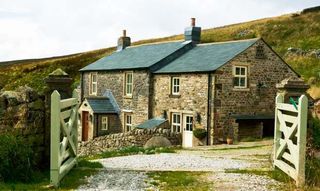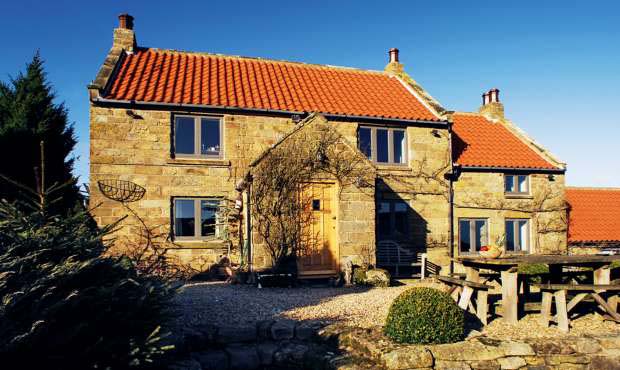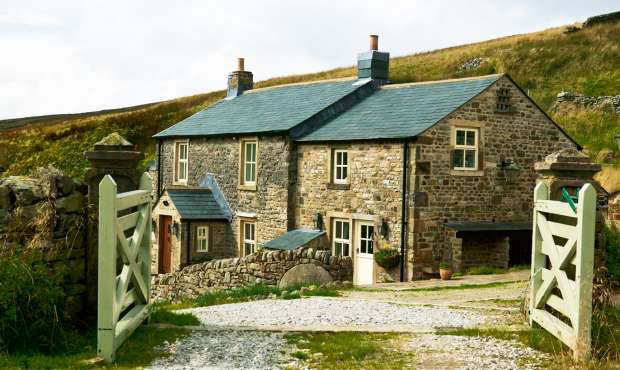How To Remove Clay Tiles To Repair A Place In The Roof

When it comes to the roof, it's mutual to observe defects flagged up in Home Buyer reports and building surveys, which accept a unique capacity to evoke dread. Fifty-fifty straightforward repairs that involve working at height can induce bouts of financial vertigo, brought nearly largely by the substantial sums to pay for scaffold rent.
Fortunately, the demand for complete re-roofing is insufficiently rare. In that location are, withal, potentially serious issues that routinely ingather up in surveys, near of which crave urgent attention to preclude leakage causing deterioration to the structure. Hither, we explain what to wait out for, the repairs required, and the potential costs* involved.
*All figures are provided as a crude guide, and volition vary depending on location.
Defective Pointing to Ridge Tiles, Hip Tiles and Verges
Identification
Defective pointing tin can be identified past:
- gaps and loose mortar at the joints between ridge tiles (which run along the acme of the roof), hip tiles that cap the 'corners' on hipped roofs, or to verges of gables or lean-to roof slopes
- slipped ridge and/or hip tiles
- missing hip irons (used to secure the tile at the bottom of the hip)
- leaks and damp within the loft and to the upper roof timbers
Implications
While relatively minor defects, they're adequately mutual. If left unchecked, the ingress of damp could disuse roof timbers. Storms may also dislodge loose ridge tiles with the potential risk of injury, too.
Remedial Work and Costs
Repair is a adequately straightforward task:
- Eroded mortar joints need repointing = £28 for one tile, plus £10 per boosted tile (add £10 if a new hip fe is needed).
- Ridge/hip tiles which take come loose tin exist rebedded with a suitably strong mortar mix = £36 per tile, plus £19 for each additional tile.
- Verges tend to need localised pointing up with mortar = £32 per tile and £xiii thereafter.
Some other area to watch is Victorian slated hipped roofs to bay windows which may take hip curl joints in lead or zinc.

Slipped and Missing Slates and Tiles
Identification
It's non unusual to spot small gaps where one or two tiles or slates accept slipped or croaky. In most cases, rain ingress is only probable to be a trouble where several adjoining tiles/slates are missing (cheers to the courses of lapped tiles/slates underneath).
Most roofs built post-1950s likewise have a layer of underlay ('sarking felt') providing a secondary defence. Whatsoever air current-blown rain that penetrates under the tiles should be safely channelled downward to the gutters.
Even so, older roofs were by and large built without any underlay, and instead relied on a good flow of air ventilating the loft to waft away any resulting clammy.
Implications
The odd dislodged or missing tile, is frequently caused past storm damage, or people walking on the roof for TV aerial/satellite dish installation. A missing tile/slate is not usually a disquisitional defect, just repair shouldn't be left for too long, especially on roofs clad with larger interlocking tiles (with less overlap), and on older roofs with torn, sagging or not-existent underlay.
Gaps between adjacent tiles/slates nearly gable ends or party walls can also develop where the roof slopes accept settled more than than the walls. Spaces of up to 10mm either side of each tile are not normally meaning, as the lapped tiles underneath cover the gap.
Remedial Piece of work
If there are only a few slipped or missing tiles or slates, they tin usually be refixed or replaced fairly hands. On shallow pitched roofs (common on 1970s properties), the underfelt tin outset to sag, diverting rainwater down wall cavities. This may mean the lower layers of underfelt need to be stripped, replaced and rebattened.
Tiles tin be decumbent to localised defects such as broken nibs. Even long-lasting plain clay tiles can eventually first to erode and crack beyond the heart or 'spall' in layers. It's relatively like shooting fish in a barrel to replace tiles considering, different slates, they're typically only nailed every fourth or 5th class.
To remove a broken tile:
- Elevator the two tiles above it with wooden wedges.
- Use a bricklayer'southward trowel to heighten the damaged tile off the batten.
- Carefully slide it out.
- Ease a replacement tile in to its place.
- Hook the nib over the crossbar.
Slate is a very durable natural cloth, only old fixing nails are prone to corrosion. Former slates can crevice beyond their width and eye, or fifty-fifty start to delaminate (scrap) in layers, too.
However, because each slate is nailed to a batten, and slate sizes vary, they are more than difficult to elevator out and supplant. Slipped slates can be refixed using copper or aluminium blend nails. Or, if just 1 or two are loose, then they can be secured using small folded metal clips known every bit 'tingles'.
Potential Costs
- Replacing a broken tile/slate = virtually £26 with £9 for each additional tile/slate.
- Refixing an existing tile/slate = around £60 for one to five tiles side by side to one another, plus hire of access equipment.
Note that modest jobs similar this are likely to attract an additional 'hassle-cistron' price premium.
Sagging Roof Slopes
Implications
Slight settlement is not normally a problem; it's fairly common next to gable ends and party walls where the rafters take settled more than bordering masonry. If the structure is satisfactory and there's no leakage, a fair amount of historic settlement can be acceptable.
On the other hand, in more severe cases a structural engineer may demand to be consulted and remedial structural piece of work undertaken. These causes include:
- Overloading — 'dishing' may be the result of past recladding with heavier modern physical roof tiles/slates without first making sure to strengthen the roof timbers.
- Weak roof timbers — rafters may take been undersized or spaced too far autonomously when the house was originally built. Or, they may have been cut (eg. for the botched installation of a rooflight) without the rafters being strengthened.
- Roof spread — the rafters have pushed outwards causing the summit of the wall to burl, which means that the rafters may sink and cause the roof to dip in the middle.
- Rotten or protrude-infested timbers — this is usually due to long-term leakage and poor ventilation.
Remedial Piece of work
Overloaded or weakened roofs can be repaired by installing additional purlins and struts to improve back up. This is fairly simple carpentry and shouldn't exist besides expensive, providing that admission is reasonable.
If sagging is due to settlement to supporting internal walls below, then the walls must be stabilised.
With roof spread, the ceiling joists normally act as collars restraining the rafters from pushing the walls outwards, so new collars may need to be installed or necktie rods inserted through the upper walls.
Rotten timbers can be cut out and new timbers spliced alongside (or bolted with metal plates). The source of leakage must be fixed and ventilation improved to disperse moisture.

Slates or Tiles Nearing the Cease of Their Life
Pinnacle tip
Handmade clay tiles or stone slates can last 250 years or more than compared to around 70 or less for some types of physical tile.
Identification
If 10 or more tiles per slope are damaged or missing, the roof is probable to be nearing the cease of its useful life and volition demand stripping and re-covering. With slate roofs, await for similar numbers of loose slates that have been refixed with small metal 'tingles'. In the loft, there may be damp smells and localised staining from water ingress.
The longevity of a roof covering depends on the quality and age of the material, and the caste of exposure. The lifespan of traditional roof coverings is generally superior to later manufactured materials.
Old tiles and slates tin can absorb h2o which and then freezes and expands. White powdery salts under the tiles tin can signal erosion and the projecting nibs at the height of each tile can pause. In older slate roofs, the undersides of slates can exist checked for signs of softening and flaking.
Implications
The need for consummate re-roofing is rare, just is a major undertaking. Surveyors tin sometimes be guilty of erring on the side of caution, so get a second opinion before major works. The urgency of this chore will also depend on the extent of the deterioration.
Information technology's worth noting that some roofers may exist tempted to use junior, cheaper materials when recladding older roofs. Like-for-like repairs are preferable on natural clay and slate roofs.
On 20th-century homes, asbestos-fibre artificial slates and tiles are adequately rare, only likely to incur boosted costs for stripping and disposal.
Remedial Work
The roof should be stripped downward to the rafters, new breathable underlay installed, rebattened and finally re-covered. With natural slate or clay tiles, it is often possible to relieve and reuse at to the lowest degree 50 per cent of the originals (reducing the cost of repair).
| Remedial Piece of work Required | Labour and Materials** |
| Strip roof of tiles/slates, battens and felt | £18/m² |
| Refelt, batten and re-tile/slate stripped roof using new tiles/slates: | |
| Manifestly clay tiles | 105/one thousand² |
| Natural slate | £151/grand² |
| Interlocking physical tiles | £44/m² |
| Artificial slate | £106/m² |
| New ridge/hip tiles | From £seventy/m² |
| Verges/undercloak pointed | From £x/yard² |
| Double eaves courses pointed | From £xiv/m² |
**Gauge price including VAT.

Lacking Flashing
Identification
Cracking tin can develop where roof slopes abut dormers, parapet walls and subsidiary roofs, or around objects such as chimney stacks and internal soil pipes that are projecting through the roof. The resulting leaks and clammy patches tin can be seen in lofts, ceilings, walls and chimney stacks.
Lead flashings are very durable but can sometimes come loose. More rarely, old atomic number 82 or zinc flashings may have split or corroded. Mortar fillets are a cheap culling to atomic number 82 and are specially prone to cracking. Brusk-life tape repairs may even have been applied, or flashings painted to temporarily seal leaks.
Implications
These sorts of defects are a common cause of leaks in older properties or extensions of poor-quality structure. Over time, ingress of clammy may have caused bordering timbers to rot, and urgent repair is ordinarily required to prevent deterioration.
Remedial Work
Such problems are non too difficult to set, although replacing any decayed timbers volition add to the complication and price.
Defective flashings should exist replaced with new leadwork. Lead is the best textile to use. Although relatively expensive, the cost can be mitigated by recycling the valuable old lead. Where a flashing has just come loose, it may simply need localised refixing.
Roofs on terraced houses can as well suffer leaks where they meet at party walls. This tends to be worse where each firm has a dissimilar type of roof covering. In this case, localised stripping will be required with the provision of sheets of pb (soakers) nether the joints, or new flashings at parapets.
Replacing Valleys
Valleys are the junctions betwixt two bordering roof slopes which allow rainwater to run to the guttering. Valleys made with preformed tiles are relatively robust and any defective tiles can be replaced. Traditional open valleys have exposed linings which can, however, deteriorate over time. Furthermore, on roofs clad with large interlocking tiles, it'southward also common for the mortar upstands either side to crack and come loose. They may but need pointing upward. Alternatively, valleys can exist relined using preformed valley trays of glass-reinforced polyester.
With older roofs, replacing traditional leadwork with matching new materials is advisable. Although atomic number 82 is a more expensive material, information technology's worth noting that labour and access account for the majority of the chore toll. To supervene upon a defective pb or zinc valley on a typical Victorian slate or tiled roof:
- The old lining is stripped back.
- The timber base of operations is checked to see if it's in sound condition.
- The erstwhile lining tin can then be replaced with new strips of lawmaking four-thickness lead turned back and raised upward at the edges (mayhap laid in several lengths overlapped by a minimum 150mm).
- A thin layer of fibrous material is inserted between the lead and the valley board (such every bit breathable membrane roofing felt — but not mineral felt).
- The pb is finally fixed in place with copper nails hidden nether the overlaps.
Typical labour costs will be about £250, with materials (lead canvass and a few tiles/slates) costing around £200 — plus the rent of the access/scaffold tower.
Butterfly Roofs
Many Georgian and early Victorian townhouses have subconscious 'butterfly roofs' with a central valley, or gutters curtained behind a front parapet wall. Being out of sight, they are prone to fail, blockage and leakage.This ofttimes results in meaning expense as they commonly require relining in new leadwork, with rotten support timbers replaced. Parapet walls in a higher place the main elevations can be prone to collapse and should be tied to party walls and the roof structure behind.
Scaffold Hire and Costs
The toll of scaffolding and admission equipment hire needs to be added to the guess prices for any of the jobs outlined in this piece.
- Scaffolding per main elevation/roof gradient, including erecting and dismantling = from £450 for four weeks
- Mobile scaffold towers up to six.2m high for pocket-sized DIY repairs = £200 per week
- Roof ladders for upper sloping roofs = £70 per week
Information technology's important to notation that the Piece of work at Height Regulations restrict the use of ladders to light, low-hazard work merely — which rules out about roofing repairs on two storey backdrop or higher. This can make small jobs relatively expensive.
Chartered surveyor Ian is the author of eight popularHaynes House Manuals and is a manager of Rightsurvey.co.britain. He is also in the process of adding a large extension to his habitation.
Source: https://www.homebuilding.co.uk/advice/how-to-repair-a-roof
Posted by: fowlerthavest.blogspot.com


0 Response to "How To Remove Clay Tiles To Repair A Place In The Roof"
Post a Comment